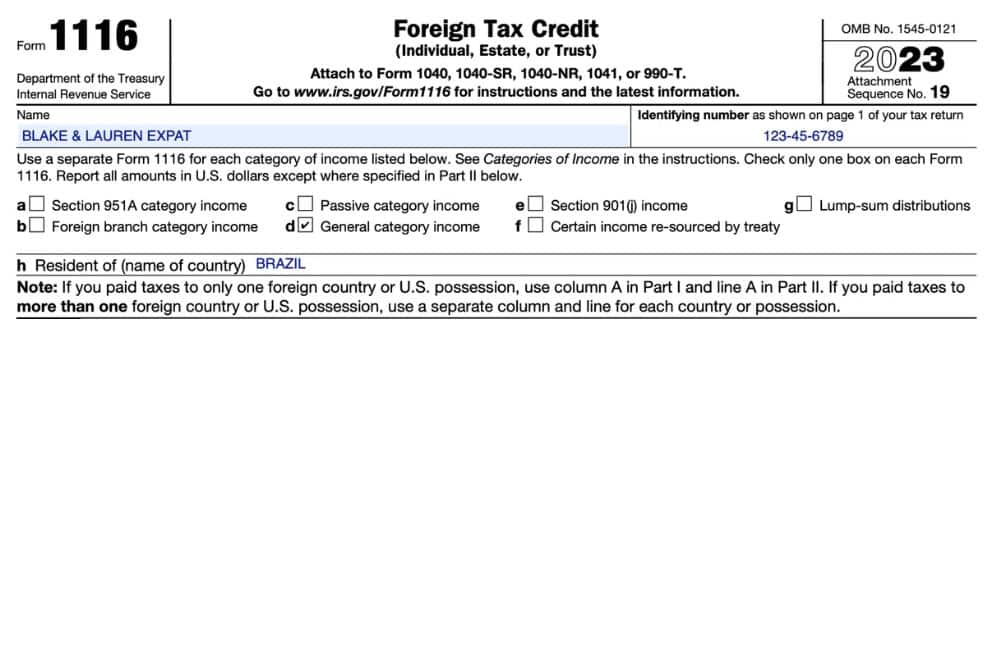Foreign Tax Credit Carryover & Carryback: A Complete Guide

- What Is the Foreign Tax Credit Carryover?
- Calculating Your Foreign Tax Credit & Carryover
- Foreign Tax Credit Carryback and Carryforward Periods
- How Is the Foreign Tax Credit Carryover Applied?
- Accumulating Carryovers on Foreign Income
- Want to Learn More About Foreign Tax Credit Carryover and Its Impact on Foreign Income? We Are Here to Help!
The Foreign Tax Credit (FTC) carryover allows US taxpayers earning abroad to carry forward unused credits for up to 10 years, offsetting future US tax liabilities. This can also be carried back to the previous year. This strategy reduces double taxation by applying foreign taxes paid against US tax obligations.
This guide will look at how to use a Foreign Tax Credit carryover to optimize your expat taxes. One of the many benefits of the Foreign Tax Credit is the ability to carry unused credits forward or back. This will allow you to reduce your tax bill over multiple years without wasting any potential savings.
Key Takeaways
- The Foreign Tax Credit lets expats subtract foreign taxes from their US tax bill.
- If you do not use the full Foreign Tax Credit amount available to you, you can carry the unused portion forward or back.
- A Foreign Tax Credit carryover can be applied to the previous year or up to 10 years after it was originally claimed.
What Is the Foreign Tax Credit Carryover?
As a US citizen, no matter where you live and work, your worldwide income is subject to US taxation. The fact that the majority of countries around the world also require you to file and pay taxes locally makes the matter even more complex.
To avoid double taxation, the US allows you to take a Foreign Tax Credit based on the foreign taxes you pay to your resident country. The Foreign Tax Credit is a dollar-for-dollar credit subtracted directly from your US taxes. If that credit is larger than your US tax bill, you can carry the excess forward or back.

For example, let’s say you were able to claim a $16,000 Foreign Tax Credit for 2022. In that same year, you owed $15,500 in taxes to the IRS. After using the Foreign Tax Credit to erase your US tax bill, you still have a $500 tax credit left over ($16,000 – $15,500 = $500). That is your Foreign Tax Credit carryover.
Now, let’s say you can claim another $16,000 Foreign Tax Credit for 2023, but this time, your US tax bill is $18,000. This leaves you with a $2,000 tax debt even after applying for the credit. However, you could also add last year’s $500 carryover to your 2023 credit amount, bringing your total Foreign Tax Credit to $16,500. This would allow you to reduce your US tax bill to just $1,500 ($18,000 – $16,500 = $1,500).
Calculating Your Foreign Tax Credit & Carryover
To calculate your Foreign Tax Credit, you will start by allocating your foreign taxes paid into categories of income. There are several categories of income for the foreign tax credit, but in practice usually only two are used.
- Passive income includes investment income such as dividends, interest, capital gains, and rent.
- General income typically includes all income not classified as passive. This category includes your salary or other earned income but can also include foreign pensions, foreign unemployment, or other foreign types of pay not classified as passive income.
Once your income is allocated to each category, you can calculate the Foreign Tax Credit. You will have to make a separate calculation for each type of income. The allowable credit for each category may be limited. You’ll calculate that limit by multiplying the total amount of US income tax liability by the percentage of taxable foreign income to total worldwide income. You need to perform this calculation to determine your percentage for each category.
Foreign Tax Credit Calculation Example
George has earned $50,000 in salary (converted from UK pounds to US dollars) while living and working in the UK. He also earned $1,000 in interest (converted from UK pounds to US dollars) from his foreign bank account. Since he has some US investments that earned $5,000 in dividend income, George’s total taxable income is $56,000. He paid $15,000 in taxes to the UK on his salary and another $200 on his interest income. The total US tax reported is $7,190.
Step 1: Allocate income to the categories of general or passive.
In his case, George’s $50,000 salary is allocated to the general income category, and his $1,000 in interest is allocated to the passive income category.
Step 2: Complete a separate copy of Form 1116 for each category of income.
Next, George will need to fill out two copies of Form 1116, one for his general income and the other for his passive income.
- For general category income, the percentage of this income to total income is calculated by dividing the $50,000 foreign earned income by $56,000 in gross income from all sources, for a result of 89.29%. We must multiply the tax liability of $7,190 by 89.29% to arrive at the allowable Foreign Tax Credit of $6,420 for general income.
- We also determine the amount of passive income to total income. This percentage is calculated by dividing the $1,000 in foreign interest by $56,000 in gross income from all sources, for a result of 1.79%. We must multiply the tax liability of $7,190 by 1.79% to arrive at the allowable Foreign Tax Credit of $128 for passive income.
Step 3: Calculate the Foreign Tax Credit carryover.
General category: Of the $15,000 in Foreign Tax Credit available, George used $6,420. The difference of $8,580 is carried over. Passive category: Of the $200 in Foreign Tax Credit available, George used $128. The difference of $72 is carried over.
Step 4: Add the total Foreign Tax Credit to reduce US taxes.
- Total US tax liability $7,190
- Foreign Tax Credit $6,548
George still owes $642 in US tax. Even though George had Foreign Tax Credits and a US tax liability, he could only use the Foreign Tax Credit to offset the tax due on foreign income. He still owes tax on the $5,000 in US dividends.
For more information on how to calculate the Foreign Tax Credit and carryover, see the instructions for Form 1116 provided on the IRS website.
Foreign Tax Credit Carryback and Carryforward Periods
A common question we get is, “When can I use the Foreign Tax Credit carryover?” There is a limit to what years you can apply for a Foreign Tax Credit carryover. Specifically, you can carry your excess credit back one year or forward up to 10 years. After 10 years, the credit carryover will expire and cannot be used.
If you are behind on your expat taxes, you may be able to use the Streamlined Filing Compliance Procedures to catch up without the usual penalties. This will allow you to claim the Foreign Tax Credit for past years.
How Is the Foreign Tax Credit Carryover Applied?
Any foreign tax paid in the current year must be first used to claim the foreign tax credit. You can then use credits from past years, starting with the year with unused tax credits furthers in the past (which are the credits that will be the first to expire).
Accumulating Carryovers on Foreign Income
If you live and pay tax in a foreign country with higher taxes than the US, you will most likely continue to accumulate Foreign Tax Credit carryovers. If you were to return to the US with a carryover credit, you could not use the credit against your US source income. The Foreign Tax Credit can only be applied against foreign income. This means the only way to use up carryover credit would be to move to a country with lower taxes than the US.
Want to Learn More About Foreign Tax Credit Carryover and Its Impact on Foreign Income? We Are Here to Help!
By using your Foreign Tax Credit carryover, you can save on your expat taxes for years to come. Contact us, and one of our customer champions will gladly help. If you need precise advice on your specific tax situation, you can also click below to get a consultation with one of our expat tax experts.




